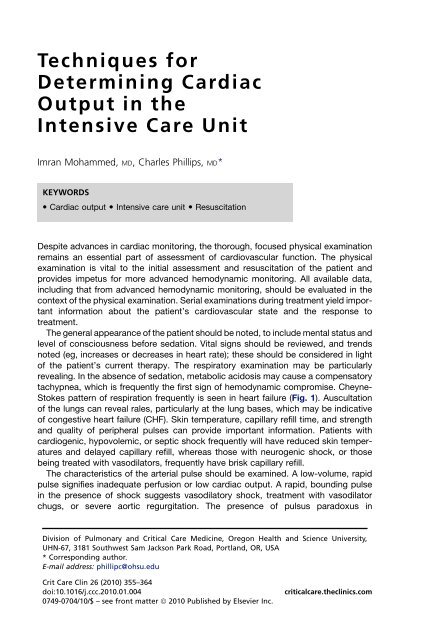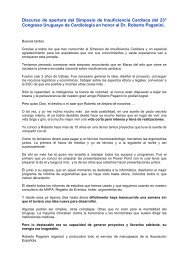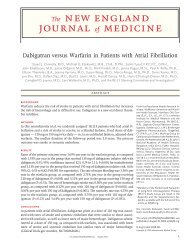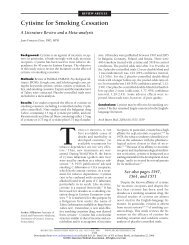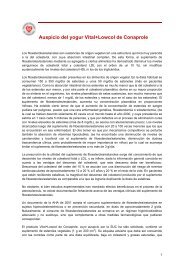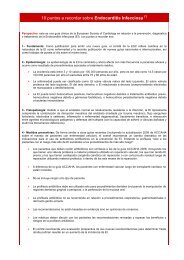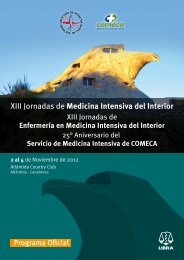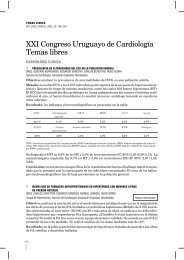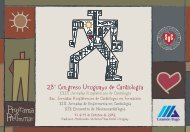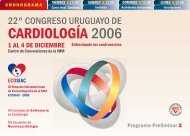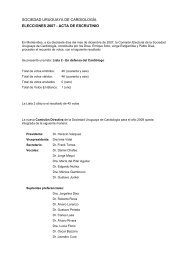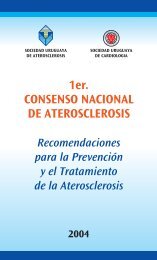Techniques for Determining Cardiac Output in the Intensive Care Unit
Techniques for Determining Cardiac Output in the Intensive Care Unit
Techniques for Determining Cardiac Output in the Intensive Care Unit
Create successful ePaper yourself
Turn your PDF publications into a flip-book with our unique Google optimized e-Paper software.
<strong>Techniques</strong> <strong>for</strong><br />
<strong>Determ<strong>in</strong><strong>in</strong>g</strong> <strong>Cardiac</strong><br />
<strong>Output</strong> <strong>in</strong> <strong>the</strong><br />
<strong>Intensive</strong> <strong>Care</strong> <strong>Unit</strong><br />
Imran Mohammed, MD, Charles Phillips, MD*<br />
KEYWORDS<br />
<strong>Cardiac</strong> output <strong>Intensive</strong> care unit Resuscitation<br />
Despite advances <strong>in</strong> cardiac monitor<strong>in</strong>g, <strong>the</strong> thorough, focused physical exam<strong>in</strong>ation<br />
rema<strong>in</strong>s an essential part of assessment of cardiovascular function. The physical<br />
exam<strong>in</strong>ation is vital to <strong>the</strong> <strong>in</strong>itial assessment and resuscitation of <strong>the</strong> patient and<br />
provides impetus <strong>for</strong> more advanced hemodynamic monitor<strong>in</strong>g. All available data,<br />
<strong>in</strong>clud<strong>in</strong>g that from advanced hemodynamic monitor<strong>in</strong>g, should be evaluated <strong>in</strong> <strong>the</strong><br />
context of <strong>the</strong> physical exam<strong>in</strong>ation. Serial exam<strong>in</strong>ations dur<strong>in</strong>g treatment yield important<br />
<strong>in</strong><strong>for</strong>mation about <strong>the</strong> patient’s cardiovascular state and <strong>the</strong> response to<br />
treatment.<br />
The general appearance of <strong>the</strong> patient should be noted, to <strong>in</strong>clude mental status and<br />
level of consciousness be<strong>for</strong>e sedation. Vital signs should be reviewed, and trends<br />
noted (eg, <strong>in</strong>creases or decreases <strong>in</strong> heart rate); <strong>the</strong>se should be considered <strong>in</strong> light<br />
of <strong>the</strong> patient’s current <strong>the</strong>rapy. The respiratory exam<strong>in</strong>ation may be particularly<br />
reveal<strong>in</strong>g. In <strong>the</strong> absence of sedation, metabolic acidosis may cause a compensatory<br />
tachypnea, which is frequently <strong>the</strong> first sign of hemodynamic compromise. Cheyne-<br />
Stokes pattern of respiration frequently is seen <strong>in</strong> heart failure (Fig. 1). Auscultation<br />
of <strong>the</strong> lungs can reveal rales, particularly at <strong>the</strong> lung bases, which may be <strong>in</strong>dicative<br />
of congestive heart failure (CHF). Sk<strong>in</strong> temperature, capillary refill time, and strength<br />
and quality of peripheral pulses can provide important <strong>in</strong><strong>for</strong>mation. Patients with<br />
cardiogenic, hypovolemic, or septic shock frequently will have reduced sk<strong>in</strong> temperatures<br />
and delayed capillary refill, whereas those with neurogenic shock, or those<br />
be<strong>in</strong>g treated with vasodilators, frequently have brisk capillary refill.<br />
The characteristics of <strong>the</strong> arterial pulse should be exam<strong>in</strong>ed. A low-volume, rapid<br />
pulse signifies <strong>in</strong>adequate perfusion or low cardiac output. A rapid, bound<strong>in</strong>g pulse<br />
<strong>in</strong> <strong>the</strong> presence of shock suggests vasodilatory shock, treatment with vasodilator<br />
chugs, or severe aortic regurgitation. The presence of pulsus paradoxus <strong>in</strong><br />
Division of Pulmonary and Critical <strong>Care</strong> Medic<strong>in</strong>e, Oregon Health and Science University,<br />
UHN-67, 3181 Southwest Sam Jackson Park Road, Portland, OR, USA<br />
* Correspond<strong>in</strong>g author.<br />
E-mail address: phillipc@ohsu.edu<br />
Crit <strong>Care</strong> Cl<strong>in</strong> 26 (2010) 355–364<br />
doi:10.1016/j.ccc.2010.01.004<br />
0749-0704/10/$ – see front matter ª 2010 Published by Elsevier Inc.<br />
criticalcare.<strong>the</strong>cl<strong>in</strong>ics.com
356<br />
Mohammed & Phillips<br />
Fig. 1. Cheyne-Stokes respiration. An abnormal type of breath<strong>in</strong>g characterized by alternat<strong>in</strong>g<br />
periods of shallow and deep breath<strong>in</strong>g.<br />
a spontaneously breath<strong>in</strong>g patient may be a reflection of severe obstructive lung<br />
disease or of cardiac tamponade. Dim<strong>in</strong>ished pulse volume and blood pressure after<br />
<strong>in</strong>itiation of positive pressure ventilation may suggest hypovolemia. Water-hammer<br />
pulse (bound<strong>in</strong>g and <strong>for</strong>ceful) and Qu<strong>in</strong>cke’ sign (pulsation of <strong>the</strong> capillary bed <strong>in</strong> <strong>the</strong><br />
nail) can reveal <strong>the</strong> presence of severe aortic <strong>in</strong>sufficiency.<br />
Assessment of neck ve<strong>in</strong>s, while frequently confounded <strong>in</strong> severely ill patients can<br />
provide useful <strong>in</strong><strong>for</strong>mation. The height of neck ve<strong>in</strong>s and <strong>the</strong> qualities of <strong>the</strong> venous<br />
pulsations can provide <strong>in</strong><strong>for</strong>mation regard<strong>in</strong>g ventricular function, <strong>in</strong>travascular<br />
volume status, pulmonary artery (PA) pressures, and right heart valvular function.<br />
Acutely distended neck ve<strong>in</strong>s may <strong>in</strong>dicate <strong>in</strong>travascular volume overload, right or<br />
left ventricular failure, pulmonary hypertension with an <strong>in</strong>competent pulmonic valve,<br />
noncompliance of <strong>the</strong> right ventricle, right ventricular outflow obstruction, or pericardial<br />
tamponade as examples. Abnormalities of <strong>the</strong> pulse contour can <strong>in</strong>dicate abnormalities<br />
of valve or myocardial function. Cannon A waves are caused when <strong>the</strong> atrium<br />
contracts aga<strong>in</strong>st a closed tricuspid valve and <strong>in</strong>dicate atrio–ventricular dysynchrony.<br />
Kussmaul’s sign is <strong>the</strong> observation of a jugular venous pressure that rises with <strong>in</strong>spiration<br />
and is seen with impediment to right heart fill<strong>in</strong>g. Abdom<strong>in</strong>o–jugular reflux<br />
(<strong>in</strong>crease <strong>in</strong> <strong>the</strong> jugular venous pulse with pressure on <strong>the</strong> abdomen) suggests <strong>the</strong><br />
presence of right ventricular failure as <strong>the</strong> right ventricle is unable to accept <strong>the</strong><br />
<strong>in</strong>creased venous return. 1,2 Heart failure can lead to passive congestion of <strong>the</strong> liver,<br />
and assess<strong>in</strong>g liver size while assess<strong>in</strong>g <strong>for</strong> abdom<strong>in</strong>o–jugular reflux can provide<br />
useful <strong>in</strong><strong>for</strong>mation. Assessment of heart rate and rhythm should be per<strong>for</strong>med,<br />
keep<strong>in</strong>g age-related norms and medications <strong>in</strong> m<strong>in</strong>d. Auscultation of <strong>the</strong> heart sounds,<br />
not<strong>in</strong>g <strong>the</strong> presence or quality of <strong>the</strong> first and second heart sounds, <strong>the</strong> presence or<br />
absence of third or fourth heart sounds, <strong>the</strong> presence and quality of murmurs, clicks,<br />
or friction rubs is important both dur<strong>in</strong>g <strong>the</strong> <strong>in</strong>itial assessment and as a means to<br />
assess response to <strong>the</strong>rapy or changes <strong>in</strong> function. The development of a friction<br />
rub after cardiac surgery is not unexpected, but <strong>the</strong> development of such a rub dur<strong>in</strong>g<br />
treatment <strong>for</strong> septic shock may <strong>in</strong>dicate <strong>the</strong> presence of pericardial <strong>in</strong>flammation and<br />
effusion. Similarly, <strong>the</strong> development of an S3 gallop may be <strong>the</strong> first clear <strong>in</strong>dication of<br />
worsen<strong>in</strong>g heart failure.<br />
MEASURING CARDIAC OUTPUT<br />
Means of measur<strong>in</strong>g cardiac output <strong>in</strong>clude<br />
Pulmonary artery ca<strong>the</strong>ter (PAC)<br />
Transpulmonary <strong>the</strong>rmodilution (TD)—PiCCO monitor (Pulsion Medical Systems,<br />
Munich, Germany)<br />
Lithium dilution—LiDCO (LiDCO Group Plc, London UK)<br />
Pulse contour analysis—calibrated (PiCCO, PulseCO system [LiDCO Ltd])—<br />
noncalibrated (Flo-trac Vigleo system [Edwards Life Sciences, Irv<strong>in</strong>e Cali<strong>for</strong>nia])<br />
Mixed and central venous saturation.
<strong>Cardiac</strong> <strong>Output</strong> <strong>in</strong> ICU 357<br />
PAC<br />
The PAC first was <strong>in</strong>troduced by Swan and Ganz <strong>in</strong> 1970. 3 The balloon-tipped, flowdirected<br />
ca<strong>the</strong>ter allowed cl<strong>in</strong>icians <strong>for</strong> <strong>the</strong> first time to assess advanced parameters<br />
of hemodynamics and gas exchange at <strong>the</strong> bedside. It was widely adopted, so much<br />
so that it helped def<strong>in</strong>e <strong>the</strong> modern <strong>in</strong>tensive care unit (ICU) <strong>in</strong> <strong>the</strong> com<strong>in</strong>g years. But<br />
<strong>the</strong> PAC was <strong>in</strong>troduced without any cl<strong>in</strong>ical trials establish<strong>in</strong>g benefit <strong>in</strong> critically ill<br />
patients, and after several years of use concerns over its safety and efficacy were<br />
raised. The device never has been shown to improve major cl<strong>in</strong>ical outcomes, 3,4 and<br />
<strong>in</strong> fact might <strong>in</strong>crease mortality and morbidity. 5,6 Fur<strong>the</strong>rmore, <strong>the</strong>re is a grow<strong>in</strong>g<br />
body of evidence that <strong>the</strong> PAC adds little to <strong>in</strong><strong>for</strong>mation atta<strong>in</strong>able by less <strong>in</strong>vasive<br />
measures, and as such, it has been suggested that it no longer be used as part of rout<strong>in</strong>e<br />
management of <strong>the</strong> critically ill <strong>for</strong> conditions o<strong>the</strong>r than right heart failure, disorders<br />
caus<strong>in</strong>g abnormalities of pulmonary arterial pressure, and congenital heart disease. 7,8<br />
<strong>Cardiac</strong> output can be determ<strong>in</strong>ed by different methods us<strong>in</strong>g <strong>the</strong> PAC. It can be<br />
measured us<strong>in</strong>g <strong>the</strong> Fick pr<strong>in</strong>ciple, which is a variation of <strong>the</strong> law of conservation<br />
and states that consumption of oxygen must equal <strong>the</strong> product of blood flow and<br />
<strong>the</strong> difference between <strong>the</strong> arterial and venous concentrations of <strong>the</strong> oxygen:<br />
CO 5 (VO 2 )/(Ca O2 ) - (Cv O2 )<br />
where VO 2 is <strong>the</strong> oxygen consumption per m<strong>in</strong>ute; Ca O2 is <strong>the</strong> arterial oxygen content,<br />
and Cv O2 is <strong>the</strong> mixed venous oxygen content.<br />
Systemic arterial and mixed venous blood samples are taken, and VO 2 is ei<strong>the</strong>r<br />
measured us<strong>in</strong>g a calorimeter or is estimated. The Fick method is quite accurate <strong>for</strong><br />
measur<strong>in</strong>g CO when VO 2 is measured directly. it loses accuracy, however, if supplemental<br />
oxygen is given at FiO 2 greater than 0.6 or when <strong>the</strong>re is significant oxygen<br />
consumption <strong>in</strong> <strong>the</strong> lung itself and VO 2 is estimated as, as is frequently <strong>the</strong> case <strong>in</strong><br />
critically ill patients.<br />
TD rema<strong>in</strong>s <strong>the</strong> most commonly used technique <strong>for</strong> obta<strong>in</strong><strong>in</strong>g cardiac output <strong>in</strong> critically<br />
ill patients. When us<strong>in</strong>g <strong>the</strong> PAC, 5 to 10 mL of cold sal<strong>in</strong>e (%25 C) is <strong>in</strong>jected<br />
through <strong>the</strong> ca<strong>the</strong>ter <strong>in</strong>to <strong>the</strong> right atrium, where it mixes with venous blood, caus<strong>in</strong>g<br />
it to cool slightly. Cooled blood <strong>the</strong>n passes through <strong>the</strong> right heart <strong>in</strong>to <strong>the</strong> PA and by<br />
a <strong>the</strong>rmistor near <strong>the</strong> tip of <strong>the</strong> PAC, and a TD curve is generated. CO <strong>the</strong>n is calculated<br />
us<strong>in</strong>g <strong>the</strong> modified Stewart-Hamilton equation <strong>for</strong> TD.<br />
VI ðTB TIÞSI CI 60 CT<br />
Q 5<br />
SB CB R N<br />
DTBðtÞdt<br />
0<br />
where Q is <strong>the</strong> CO (L/m<strong>in</strong>), VI is <strong>the</strong> volume of <strong>in</strong>jectant (milliliters); TB is <strong>the</strong> blood<br />
temperature ( C). SI is <strong>the</strong> specific gravity of <strong>in</strong>jectant; CI is <strong>the</strong> specific heat of <strong>in</strong>jectate,<br />
and 60 is a constant <strong>for</strong> number of seconds per m<strong>in</strong>ute. CT is <strong>the</strong> correction<br />
factor,<br />
R<br />
and SB is <strong>the</strong> specific gravity of blood, CB is <strong>the</strong> specific heat of blood, and<br />
N D is <strong>the</strong> <strong>in</strong>tegral of blood temperature change 0<br />
( C/sec) (area under <strong>the</strong> TD curve).<br />
The correction factor CT depends on <strong>the</strong> length from <strong>the</strong> proximal port of <strong>the</strong> PA ca<strong>the</strong>ter<br />
to <strong>the</strong> <strong>the</strong>rmistor and <strong>the</strong> response time and sensitivity of <strong>the</strong> <strong>the</strong>rmistor and electronic<br />
circuitry supplied by <strong>the</strong> manufacturer. Wide variation <strong>in</strong> CO occurs over <strong>the</strong><br />
course of <strong>the</strong> respiratory cycle, and it is important to beg<strong>in</strong> and complete each <strong>in</strong>jection<br />
at <strong>the</strong> same time <strong>in</strong> <strong>the</strong> cycle. Injection is done <strong>in</strong> triplicate, and values are averaged.<br />
As <strong>the</strong> <strong>in</strong>jections are be<strong>in</strong>g done, it is important to remember any loss of<br />
<strong>the</strong>rmal <strong>in</strong>dicator through right-to-left <strong>in</strong>tracardiac shunts or remix<strong>in</strong>g across <strong>in</strong>competent<br />
pulmonary or tricuspid valves will cause erroneous <strong>in</strong>creases <strong>in</strong> CO. Similarly,
358<br />
Mohammed & Phillips<br />
a large volume of <strong>in</strong>jectate or too slow an <strong>in</strong>jection can lead to a falsely low CO measurement.<br />
Temperature errors can occur with concomitant cont<strong>in</strong>uous <strong>in</strong>travenous <strong>in</strong>fusions<br />
<strong>in</strong>to <strong>the</strong> central ve<strong>in</strong>s. Thrombus or vessel wall imp<strong>in</strong>gement also can alter <strong>the</strong><br />
<strong>the</strong>rmistor function. Arrhythmias and atrial or ventricular ectopy can cause wide sw<strong>in</strong>gs<br />
<strong>in</strong> preload and CO, confound<strong>in</strong>g average CO determ<strong>in</strong>ation. It is important to remember<br />
that even <strong>in</strong> <strong>the</strong> best circumstances, accuracy is only to 10% to 15% of <strong>the</strong> actual value,<br />
and any change <strong>in</strong> CO less <strong>the</strong>n that should not be <strong>in</strong>terpreted as significant. 3<br />
Complications of PAC are:<br />
L<strong>in</strong>e-related complications (pneumothorax, bleed<strong>in</strong>g or <strong>in</strong>fections)<br />
Arrhythmias (benign and life-threaten<strong>in</strong>g ventricular arrhythmias and right bundle<br />
branch block)<br />
PA-related complications (rupture, <strong>in</strong>farction, thrombi, hemorrhage, vegetations).<br />
Transpulmonary TD<br />
Whereas <strong>the</strong> PAC rema<strong>in</strong>s widely used, controversy surround<strong>in</strong>g its safety and efficacy<br />
has prompted development of newer less <strong>in</strong>vasive techniques. For <strong>the</strong>se<br />
purposes, <strong>the</strong> transpulmonary <strong>the</strong>rmodilution technique (TPT) allows assessment of<br />
volumetric preload, cardiac output, and extravascular lung water without <strong>the</strong> need<br />
to pass a ca<strong>the</strong>ter through <strong>the</strong> right heart.<br />
The PiCCO monitor is currently <strong>the</strong> only commercially available device that uses <strong>the</strong><br />
TPT method to measure cardiac output. The device requires only central venous<br />
access and a specialized femoral or axillary arterial ca<strong>the</strong>ter with a <strong>the</strong>rmistor at its<br />
tip. A known volume of <strong>the</strong>rmal <strong>in</strong>dicator (ice-cold sal<strong>in</strong>e) is <strong>in</strong>jected via a central<br />
venous ca<strong>the</strong>ter. The result<strong>in</strong>g packet of cooler blood traverses <strong>the</strong> thorax and is<br />
sensed by a <strong>the</strong>rmistor <strong>in</strong> <strong>the</strong> femoral or axillary position generat<strong>in</strong>g a TD dissipation<br />
curve. <strong>Cardiac</strong> output is <strong>the</strong>n calculated from <strong>the</strong> curve us<strong>in</strong>g <strong>the</strong> modified Stewart-<br />
Hamilton equation <strong>for</strong> TD (as described <strong>in</strong> <strong>the</strong> PAC section). The average result from<br />
three consecutive bolus <strong>in</strong>jections is recorded.<br />
The technique is less <strong>in</strong>vasive than <strong>the</strong> PAC, requir<strong>in</strong>g only central venous and arterial<br />
l<strong>in</strong>es, which many critically ill patients already will have required. Earlier studies 9<br />
found <strong>the</strong> measurements of PiCCO are more consistent and are not <strong>in</strong>fluenced by<br />
respiratory cycle as compared with PAC. Its suitability to use <strong>in</strong> pediatric patients<br />
and reliability <strong>in</strong> cardiac unstable patients also are accepted. 10 TPT may give <strong>in</strong>accurate<br />
measurements <strong>in</strong> patients with <strong>in</strong>tracardiac shunt, aortic stenosis, aortic aneurysm,<br />
and extra corporeal circulation. Complications are all ca<strong>the</strong>ter-related to<br />
<strong>in</strong>clude <strong>in</strong>fection (
<strong>Cardiac</strong> <strong>Output</strong> <strong>in</strong> ICU 359<br />
Pulse Contour Wave<strong>for</strong>m Analysis<br />
Pulse contour analysis uses pressure wave<strong>for</strong>ms <strong>in</strong> arterial blood <strong>in</strong> <strong>the</strong> periphery to<br />
cont<strong>in</strong>uously calculate CO. Wessel<strong>in</strong>g first described a cl<strong>in</strong>ically usable technique <strong>in</strong><br />
1983. 12 The arterial pressure wave<strong>for</strong>m is obta<strong>in</strong>ed <strong>in</strong> <strong>the</strong> axillary or femoral arteries,<br />
and <strong>the</strong>n assumptions are made to calculate predicted changes <strong>in</strong> pulse wave contour<br />
measured <strong>in</strong> <strong>the</strong> periphery <strong>in</strong> an attempt to estimate stroke volume (SV). The area<br />
under <strong>the</strong> systolic portion of <strong>the</strong> pressure wave<strong>for</strong>m is proportional to <strong>the</strong> SV as <strong>the</strong><br />
<strong>in</strong>tegral of <strong>the</strong> change <strong>in</strong> pressure from end diastole (t 0 ) to end systole (t 1 ) over time<br />
and <strong>in</strong>versely proportional to <strong>the</strong> impedence of <strong>the</strong> aorta (Z).<br />
R t1<br />
t0<br />
SV 5<br />
dP=dt<br />
Z<br />
Sophisticated wave<strong>for</strong>m analyses are employed, which account <strong>for</strong> f<strong>in</strong>ite pulse<br />
wave velocity and wave reflections. Accuracy <strong>the</strong>n is enhanced fur<strong>the</strong>r by calibration<br />
with an <strong>in</strong>dicator dilution technique: transpulmonary TD <strong>for</strong> <strong>the</strong> PiCCO system and<br />
lithium chloride dilution <strong>for</strong> <strong>the</strong> PulseCO system (LiDCO Ltd). Studies compar<strong>in</strong>g CO<br />
by pulse contour analysis techniques to <strong>the</strong> PA TD technique have found fairly good<br />
correlations with a correlation coefficient (r) rang<strong>in</strong>g from 0.88 to 0.98 and precisions<br />
of 0.3 to 1.26 L/m<strong>in</strong>. 13,14 Variable results have been reported <strong>in</strong> studies <strong>in</strong>volv<strong>in</strong>g<br />
patients with rapidly chang<strong>in</strong>g hemodynamics after <strong>in</strong>itial calibration, but it is felt<br />
that <strong>the</strong> negative impact that hemodynamic <strong>in</strong>stability has on this technique can be<br />
m<strong>in</strong>imized by more frequent calibrations. 15<br />
Nei<strong>the</strong>r system requires right heart ca<strong>the</strong>terization, mak<strong>in</strong>g <strong>the</strong>m less <strong>in</strong>vasive than<br />
PACs, but <strong>the</strong>y do require placement of both arterial and venous l<strong>in</strong>es. Factors<br />
affect<strong>in</strong>g accuracy <strong>in</strong>clude: nonl<strong>in</strong>earity of aortic compliance, differences <strong>in</strong> proximal<br />
aortic pressure to measure peripheral pressure, damped wave<strong>for</strong>ms, variability of<br />
aortic diameter, aortic valve and vessel pathology, and body position. 16<br />
Pulse Contour <strong>Cardiac</strong> <strong>Output</strong> (Noncalibrated)—Flo-trac Vigleo System<br />
The FloTrac system, comprised of <strong>the</strong> FloTrac sensor and Vigileo monitor, attempts to<br />
determ<strong>in</strong>e CO by pulse contour analysis without employ<strong>in</strong>g a second technique <strong>for</strong><br />
calibration. Calibration allows a way to account <strong>for</strong> changes <strong>in</strong> vascular compliance,<br />
which cannot be easily measured cl<strong>in</strong>ically. The makers of <strong>the</strong> Flo-Trac device claim<br />
to have solved this problem us<strong>in</strong>g cont<strong>in</strong>uous self-calibration through an automatic<br />
vascular tone adjustment <strong>in</strong>volv<strong>in</strong>g complex algorithms based on mean arterial pressure,<br />
age, height, weight, and gender of patients. Although accuracy of this system<br />
has been promis<strong>in</strong>g <strong>in</strong> limited studies <strong>in</strong>volv<strong>in</strong>g fairly stable patients, fur<strong>the</strong>r validation<br />
studies <strong>in</strong> severely ill patients are required. 17,18<br />
Mixed Venous Oxygen Saturation—Surrogate of CO<br />
Mixed venous oxygen saturation requires sampl<strong>in</strong>g of blood <strong>in</strong> <strong>the</strong> pulmonary artery<br />
with a pulmonary artery ca<strong>the</strong>ter (PAC). A low mixed venous saturation (Svo2) <strong>in</strong> <strong>the</strong><br />
absence of arterial hypoxemia is considered as a surrogate marker of poor cardiac<br />
output. Normal mixed venous saturation is approximately 70%. A very low mixed<br />
venous saturation (Svo2) is <strong>in</strong>dicative of excessive extraction of oxygen per unit<br />
blood—under-resuscitation. A very high Svo2 value is difficult to <strong>in</strong>terpret. It may<br />
represent <strong>the</strong> <strong>in</strong>ability of <strong>the</strong> tissues to extract oxygen (cytopathic dysoxia seen <strong>in</strong><br />
sepsis, mitochondrial poison<strong>in</strong>g and dysfunction seen <strong>in</strong> various conditions and exposures,<br />
or <strong>in</strong>creased CO and oxygen delivery).
360<br />
Mohammed & Phillips<br />
Because of <strong>the</strong> need to place a PAC to obta<strong>in</strong> mixed venous oxygen saturation, <strong>the</strong><br />
use of central venous blood saturation has recently ga<strong>in</strong>ed popularity. A study of 12<br />
patients undergo<strong>in</strong>g abdom<strong>in</strong>al aortic surgery showed good correlation (P
<strong>Cardiac</strong> <strong>Output</strong> <strong>in</strong> ICU 361<br />
Fig. 2. Thoracic bioimpedence uses a tetrapolar system of electrodes, separat<strong>in</strong>g <strong>the</strong> current<br />
pathway from <strong>the</strong> sens<strong>in</strong>g pathway. Current is <strong>in</strong>jected, and <strong>the</strong> impendence aga<strong>in</strong>st <strong>the</strong><br />
flow of <strong>the</strong> current through <strong>the</strong> thorax along <strong>the</strong> path of least resistance is measured (ie,<br />
<strong>the</strong> great vessels).<br />
shown that when patients with <strong>the</strong>se confounders were excluded, correlation to TD<br />
determ<strong>in</strong>ation of CO was improved to r 5 .93. 24<br />
Electrical Bioreactance Cardiography<br />
To overcome some of <strong>the</strong> limitations and cl<strong>in</strong>ical confounders of bioimpedence, bioreactance<br />
recently has been employed as a means to measure CO non<strong>in</strong>vasively.<br />
Whereas bioimpedence is based on changes <strong>in</strong> amplitude of electrical resistivity as<br />
a function of CO, bioreactance is based on changes <strong>in</strong> frequency. Similar to FM radio,<br />
<strong>the</strong> signal is less susceptible to <strong>in</strong>terference from chest wall movement, chest wall and<br />
lung edema, and pleural fluid (Fig. 3). Additionally, detection of frequency modulation<br />
is not as affected by <strong>the</strong> distance of electrode placement, so <strong>the</strong> electrodes can be<br />
placed anywhere on <strong>the</strong> chest.<br />
The method used by <strong>the</strong> CheetahTM monitor (Cheetah Medical, Tel Aviv, Israel and<br />
Portland, Oregon) has shown good correlation with TD <strong>in</strong> several studies <strong>in</strong> critically ill<br />
patients. 25,26 A recent prospective pilot study between septic and nonseptic patients<br />
revealed significant differences <strong>in</strong> SV, cardiac <strong>in</strong>dex and peripheral vascular resistance,<br />
and predicted <strong>the</strong> need <strong>for</strong> hospitalization <strong>in</strong> sepsis. 27 Ano<strong>the</strong>r study <strong>in</strong><br />
Fig. 3. Difference of AM and FM modulation. Bioimpedence with amplitude variability and<br />
Bioreactance with frequency variability or phase shift.
362<br />
Mohammed & Phillips<br />
postoperative cardiac surgery patients compared bioreactance and pulse contour<br />
analysis (Flo-Trac Vigileo) with PAC TD and showed similar correlations of <strong>the</strong> two<br />
techniques to TD (0.77 and 0.69, respectively). Sensitivity and specificity <strong>for</strong> predict<strong>in</strong>g<br />
trends <strong>in</strong> changes <strong>in</strong> cardiac output changes were 0.91 and 0.95, respectively, <strong>for</strong> <strong>the</strong><br />
bioreactance and 0.86 and 0.92, respectively, <strong>for</strong> <strong>the</strong> FloTrac-Vigileo. 28<br />
Esophageal Doppler Technique<br />
The esophageal Doppler technique measures blood flow velocity <strong>in</strong> descend<strong>in</strong>g<br />
aorta by a Doppler transducer (4 MHz cont<strong>in</strong>uous or 5 MHz pulsed wave) placed<br />
on <strong>the</strong> tip of an esophageal probe. The probe is <strong>in</strong>troduced <strong>in</strong> <strong>the</strong> esophagus and<br />
rotated toward <strong>the</strong> descend<strong>in</strong>g aorta. The depth, rotation of <strong>the</strong> probe, and ga<strong>in</strong><br />
are adjusted to obta<strong>in</strong> an optimal aortic velocity signal. The position<strong>in</strong>g of probe is<br />
critical <strong>in</strong> estimat<strong>in</strong>g CO, as poor position<strong>in</strong>g can lead to underestimation of CO. It<br />
is operator-dependent and requires specialized tra<strong>in</strong><strong>in</strong>g to use effectively. Studies<br />
have shown good correlation to TD (r 5 .95). 29 Advantages to its use are that it is<br />
relatively less <strong>in</strong>vasive than a PAC, and it provides cont<strong>in</strong>uous flow <strong>in</strong><strong>for</strong>mation.<br />
Disadvantages are its <strong>in</strong>itial cost, <strong>the</strong> need <strong>for</strong> sedation, and <strong>the</strong> need <strong>for</strong> a specialist<br />
tra<strong>in</strong>ed <strong>in</strong> its use.<br />
Transgastric Doppler Technique<br />
Transgastric Doppler is a similar technique to esophageal Doppler with <strong>the</strong> probe<br />
positioned <strong>in</strong> <strong>the</strong> stomach <strong>in</strong>stead of esophagus. In this technique, a th<strong>in</strong>ner silicone<br />
probe (6 mm) is used, and its placement usually does not require sedation. The th<strong>in</strong>ner<br />
probe can be more difficult to position, and it requires frequent reposition<strong>in</strong>g. It has<br />
been shown to have acceptable correlation to TD <strong>in</strong> a study of 31 patients with 57<br />
simultaneous TD and Doppler read<strong>in</strong>gs, which revealed a close correlation with r 5<br />
.91, and P
<strong>Cardiac</strong> <strong>Output</strong> <strong>in</strong> ICU 363<br />
REFERENCES<br />
1. Butman SM, Ewy GA, Standen JR, et al. Bedside cardiovascular exam<strong>in</strong>ation <strong>in</strong><br />
patients with severe chronic heart failure: importance of rest or <strong>in</strong>ducible jugular<br />
venous distension. J Am Coll Cardiol 1993;22(4):968–74.<br />
2. Garg N, Garg N. Jugular venous pulse: an appraisal. J Indian Acad Cl<strong>in</strong> Med<br />
2000;1(3):260–9.<br />
3. Cook LB, Morgan M. Pulmonary artery ca<strong>the</strong>terisation. Ann Acad Med S<strong>in</strong>gapore<br />
1994;23(4):519–30.<br />
4. Guyatt G. A randomized control trial of right-heart ca<strong>the</strong>terization<strong>in</strong> critically ill<br />
patients. Ontario <strong>Intensive</strong> <strong>Care</strong> Study Group. J <strong>Intensive</strong> <strong>Care</strong> Med 1991;6:91–5.<br />
5. Hayes MA, Timm<strong>in</strong>s AC, Yau EH, et al. Elevation of systemic oxygen delivery <strong>in</strong><br />
<strong>the</strong> treatment of critically ill patients. N Engl J Med 1994;330:1717–22.<br />
6. Dalen JE, Bone RC. Is it time to pull <strong>the</strong> pulmonary artery ca<strong>the</strong>ter? JAMA 1996;<br />
276:916–8.<br />
7. Vernon C, Phillips CR. Pulmonary artery ca<strong>the</strong>ters <strong>in</strong> acute heart failure: end of an<br />
era? Crit <strong>Care</strong> 2009;13(6):1003.<br />
8. Shure D. Pulmonary artery ca<strong>the</strong>ters—peace at last? N Engl J Med 2006;354(21):<br />
2273–4.<br />
9. Sakka SG, Rühl CC, Pfeiffer UJ, et al. Assessment of cardiac preload and extravascular<br />
lung water by s<strong>in</strong>gle transpulmonary <strong>the</strong>rmodilution. <strong>Intensive</strong> <strong>Care</strong> Med<br />
2000;26(2):180–7.<br />
10. Goedje O, Hoeke K, Lichtwarck-Aschoff M, et al. Cont<strong>in</strong>uous cardiac output by<br />
femoral arterial <strong>the</strong>rmodilution calibrated pulse contour analysis: comparison<br />
with pulmonary arterial <strong>the</strong>rmodilution. Crit <strong>Care</strong> Med 1999;27(11):2407–12.<br />
11. L<strong>in</strong>ton RA, Jonas MM, Tibby SM, et al. <strong>Cardiac</strong> output measured by lithium dilution<br />
and transpulmonary <strong>the</strong>rmodilution <strong>in</strong> patients <strong>in</strong> a paediatric <strong>in</strong>tensive care<br />
unit. <strong>Intensive</strong> <strong>Care</strong> Med 2000;26(10):1507–11.<br />
12. Wessel<strong>in</strong>g KH, Dewitt B, Weber AP. A simple device <strong>for</strong> <strong>the</strong> cont<strong>in</strong>uous measurement<br />
of cardiac output. Adv Cardiovasc Phys 1983;5:1–52.<br />
13. Buhre W, Weyland A, Kazmaier S, et al. Comparison of cardiac output assessed<br />
by pulse-contour analysis and <strong>the</strong>rmodilution <strong>in</strong> patients undergo<strong>in</strong>g m<strong>in</strong>imally<br />
<strong>in</strong>vasive direct coronary artery bypass graft<strong>in</strong>g. J Cardiothorac Vasc Anesth<br />
1999;13(4):437–40.<br />
14. Zollner C, Haller M, Weis M, et al. Beat-to-beat measurement of cardiac output by<br />
<strong>in</strong>travascular pulse contour analysis: a prospective criterion standard study <strong>in</strong><br />
patients after cardiac surgery. J Cardiothorac Vasc Anesth 2000;14(2):125–9.<br />
15. Hamzaoui O, Monnet X, Richard C, et al. Effects of changes <strong>in</strong> vascular tone on<br />
<strong>the</strong> agreement between pulse contour and transpulmonary <strong>the</strong>rmodilution<br />
cardiac output measurements with<strong>in</strong> an up to 6-hour calibration-free period.<br />
Crit <strong>Care</strong> Med 2008;36(2):434–40.<br />
16. van Lieshout JJ, Wessel<strong>in</strong>g KH. Cont<strong>in</strong>uous cardiac output by pulse contour analysis?<br />
Br J Anaesth 2001;86(4):467–9.<br />
17. Marik PE, Baram M. Non<strong>in</strong>vasive hemodynamic monitor<strong>in</strong>g <strong>in</strong> <strong>the</strong> <strong>in</strong>tensive care<br />
unit. Crit <strong>Care</strong> Cl<strong>in</strong> 2007;23(3):383–400.<br />
18. Pestaña D, Garcıa de Lorenzo A, Madero R. Relationship between mixed venous<br />
saturation and cardiac <strong>in</strong>dex, hemoglob<strong>in</strong> and oxygen consumption <strong>in</strong> aortic<br />
surgery. Rev Esp Anestesiol Reanim 1998;45(4):136–40.<br />
19. Nuñez S, Maisel A. Comparison between mixed venous oxygen saturation and<br />
<strong>the</strong>rmodilution cardiac output <strong>in</strong> monitor<strong>in</strong>g patients with severe heart failure<br />
treated with milr<strong>in</strong>one and dobutam<strong>in</strong>e. Am Heart J 1998;135(3):383–8.
364<br />
Mohammed & Phillips<br />
20. Kubicek WG, Karnegis JN, Patterson RP, et al. Development and evaluation of an<br />
impedence cardiac output system. Aerosp Med 1966;37(12):1208–12.<br />
21. Summers RL, Shoemaker WC, Peacock WF, et al. Bench to bedside: electrophysiologic<br />
and cl<strong>in</strong>ical pr<strong>in</strong>ciples of non<strong>in</strong>vasive hemodynamic monitor<strong>in</strong>g us<strong>in</strong>g<br />
impedence cardiography. Acad Emerg Med 2003;10(6):669–80.<br />
22. Raaijmakers E, Faes TJ, Scholten RJ, et al. A meta-analysis of three decades of<br />
validat<strong>in</strong>g thoracic impedance cardiography. Crit <strong>Care</strong> Med 1999;27(6):1203–13.<br />
23. Sageman WS, Amundson DE. Thoracic electrical bioimpedence measurement of<br />
cardiac output <strong>in</strong> postaortocoronary bypass patients. Crit <strong>Care</strong> Med 1993;21(8):<br />
1139–42.<br />
24. Colombo J, Shoemaker WC, Belzberg H. Non<strong>in</strong>vasive monitor<strong>in</strong>g of <strong>the</strong> autonomic<br />
nervous system and hemodynamics of patients with blunt and penetrat<strong>in</strong>g<br />
trauma. J Trauma 2008;65(6):1364–73.<br />
25. Raval NY, Squara P, Cleman M, et al. Multicenter evaluation of non<strong>in</strong>vasive<br />
cardiac output measurement by bioreactance technique. J Cl<strong>in</strong> Monit Comput<br />
2008;22(2):113–9.<br />
26. Squara P, Denjean D, Estagnasie P, et al. Non<strong>in</strong>vasive cardiac output monitor<strong>in</strong>g<br />
(NICOM): a cl<strong>in</strong>ical validation. <strong>Intensive</strong> <strong>Care</strong> Med 2007;33(7):1191–4.<br />
27. Hicks C. Hemodynamic changes <strong>in</strong> patients with sepsis. Acad Emerg Med 2009;<br />
16:397.<br />
28. Marque S, Cariou A, Chiche JD, et al. Comparison between Flotrac-Vigileo and<br />
Bioreactance, a totally non<strong>in</strong>vasive method <strong>for</strong> cardiac output monitor<strong>in</strong>g. Crit<br />
<strong>Care</strong> 2009;13(3):R73.<br />
29. Valtier B, Cholley BP, Belot JP, et al. Non<strong>in</strong>vasive monitor<strong>in</strong>g of cardiac output <strong>in</strong><br />
critically ill patients us<strong>in</strong>g transesophageal Doppler. Am J Respir Crit <strong>Care</strong> Med<br />
1998;158(1):77–83.<br />
30. Katz WE, Gasior TA, Qu<strong>in</strong>lan JJ, et al. Transgastric cont<strong>in</strong>uous-wave Doppler to<br />
determ<strong>in</strong>e cardiac output. Am J Cardiol 1993;71(10):853–7.<br />
31. Thom O, Taylor DM, Wolfe RE, et al. Comparison of a suprasternal cardiac output<br />
monitor (USCOM) with <strong>the</strong> pulmonary artery ca<strong>the</strong>ter. Br J Anaesth 2009;103(6):<br />
800–4.


